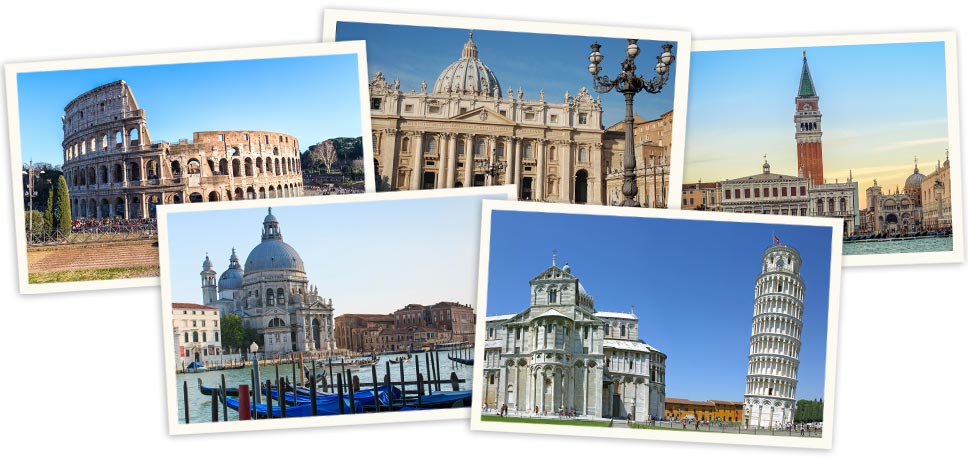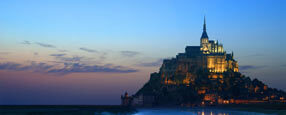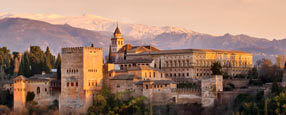ITALY TOUR with Midlands Technical College
Featuring:
Cost from: 3595 USD
ITINERARY IN BRIEF
Today we arrive in Venice and transfer to our hotel in Mestre,* the new town of Venice. No local guide provided today.
Venice, "La Serenissima" -- the "Most Serene" -- was once a powerful maritime republic, queen of the eastern Mediterranean, and Europe's gateway and entrepot for the wealth of trade coming from the Orient.
* WHY WE STAY IN MESTRE: Central hotels are of poor value with tiny rooms and lots of outside noise.
Overnight in Venice (Mestre).
Meals Included: Dinner
On our guided tour this morning we concentrate on St Mark's Square, surrounded with elegant, historic buildings.
Napoleon called Piazza San Marco,"the drawing room of Europe". We start with a tour of the Doge's Palace. This former seat of Venetian power has the second largest wooden room in Europe. Of interest as we walk through the council rooms, is Tintoretto's Paradise over the Grand Council Chamber -- alleged to be the largest oil painting in the world. The palace is connected to the old prison by the 'Bridge of Sighs.' In the late 16th century the decision was made to build new airier prison cells to replace the original dark dungeons. It was from this new prison that Casanova made his daring escape across the rooftops in 1755.
The highlight of the square is St Mark's Basilica, a Byzantine masterpiece. This cathedral was begun in 830 to house the tomb of St Mark whose relics were stolen from Alexandria in Egypt. The inside walls are encrusted with precious art, rare marbles and magnificent mosaics. Behind the altar is the famous gold altarpiece, 'Palla d'Oro,' which is one of the finest examples of gold craftsmanship. (We do not include a tour of the interior of the basilica as lengthy queues usually make this impractical for our programme. We encourage you to visit the site during your free time this afternoon.)
Later we take the vaporetto, or public water bus, on the Grand Canal and then walk along the maze of canals, sidewalks and bridges that are uniquely Venice. At the Rialto Bridge we visit the market area. The name Rialto derives from 'high bank' because this area was one of the highest points on the islands that make up the core of Venice and was thus considered a safe gathering point. The market here is vibrant with locals buying fruit and vegetables brought in from the mainland, and a vast array of fish caught fresh in the Adriatic.
Balance of the day at leisure.
Overnight in Venice (Mestre).
Meals Included: Breakfast and Dinner
Today is a "flexi" day to accomplish any sightseeing deferred from earlier, or for sightseeing at the discretion of Father Pollock.
Overnight in Venice (Mestre).
Meals Included: Breakfast and Dinner
Today we travel by train to Florence, renowned as the birthplace of the Renaissance.
Florence is a city steeped in history and art. On arrival in Florence we have a guided tour of the Accademia, which was Europe's first Academy of drawing and today houses a superb art collection, including Michelangelo's David, probably the most famous statue in the world. We then proceed to the Cathedral of Santa Maria del Fiore (Duomo), complete with its magnificent red dome. Upon its completion in 1436, the dome was hailed as the greatest architectural achievement of its day, equaling, perhaps even surpassing, the monuments of antiquity. The cupola's diameter is greater than that of St Peter's in Rome and the nave is the third largest in Christendom. Even today its brilliant engineering is not fully understood.
Overnight in Florence.
Meals Included: Breakfast and Dinner
Today is free for independent exploration.
We recommend a visit to the Uffizi Gallery, Giorgio Vasari's extraordinary administrative buildings which he designed for Cosimo I Medici in the mid-sixteenth century. The galleries here contain the greatest collection of Italian artworks, including hundreds of paintings by such great artists as Botticelli, Leonardo da Vinci, Raphael, Michelangelo, Titian and Caravaggio. The galleries also contain one of the most famous paintings in the world -- Botticelli's 'Birth of Venus.' As the Uffizi is very popular and always busy, we recommend that you book a ticket and time online at www.uffizi.com.
You could also enjoy a pleasant stroll along the pedestrian mall to the Ponte Vecchio, the oldest bridge in Florence and the only one in the city to survive World War II. The Ponte Vecchio was built in 1345 and used to be lined with butchers' shops which have now been replaced by rows of gold and silver shops on both sides. At the Piazza Santa Croce, stop to admire the facade of the Franciscan church of the same name. Inside you can see the tombs of Michelangelo and Galileo Galilei and chapels covered in frescoes by Giotto.
Overnight in Florence.
Meals Included: Breakfast and Dinner
This morning we drive from Florence to Assisi via Pisa, where we will spend most of our time concentrating on the town's principal monuments -- the Duomo, the Baptistery, and the Campo Santo Cemetery, a jewel of early gothic architecture, the grounds of which are said to be sewn with earth from the Holy Land. The most famous structure in Pisa is, of course, the gravity-defying "Leaning Tower" that Galileo carried out his experiments into the speeds of falling objects. We will take ample time to view and photograph the tower from the outside (to climb the tower requires advance reservations and a considerable amount of time to queue for entry; time constraints make this impractical for our tour).
Our final destination is Assisi. Despite the millions of tourists and pilgrims it attracts every year, the home town of St Francis remains a beautiful and tranquil refuge. St Francis was born here in 1182 and his spirit hovers over every aspect of the city's life. He renounced his father's wealth in his late teens to pursue a life of chastity and poverty, founding the order of mendicant friars known as the Order of Minors
(the Franciscans after his death) which attracted a huge following in Europe.
St Francis' Basilica is the city's, and possibly Umbria's, primary attraction. Unfortunately, this peaceful town was hit by a strong earthquake on the morning of the September 26, 1997. During the initial shock, the Basilica of the upper church was damaged. An aftershock later that day brought the cupola down. The community of Assisi with assistance from individuals and organizations worldwide is now trying to save and restore as much of Assisi's priceless masterpieces as possible.
Overnight in Assisi.
Today we travel by road to Sorrento.
En route we make an excursion to Pompeii, dug out from the inundation of volcanic ash and pumice stone that covered it by the eruption of Mount Vesuvius in AD 79. The entire area is a fantastic record of how ordinary Romans lived their lives. We will see the House of Vetti, the most elegant of the Pompeii villas and we also look at the House of Mysteries. The nearby House of Faun takes up a city block and has four different dining parlours and two spacious gardens.
We continue to Sorrento, the place where the Greeks placed the legendary abode of the Sirens, those wicked mermaids who lured seamen to their deaths with their sweet songs. The Sorrento Peninsula, a finger of land curling around the Bay of Naples, is beautiful with its soaring mountains and colourful flora.
Overnight in Sorrento.
Meals Included: Breakfast and Dinner
In the morning, we head back to Rome for a day of leisure on your own. There will be no local guide provided today.
Overnight in Rome.
Meals Included: Breakfast and Dinner
Today we begin our visit to Vatican City with a guided tour through the immense Vatican Museums. This amazing collection houses some of the most important Greek and Roman sculptures, Renaissance paintings, Flemish tapestries and mosaics in the world. We also visit Michelangelo's Sistine Chapel to take in the breathtaking frescoes. Heading into the cavernous interior of St. Peter's Basilica we can appreciate it's many treasures including Michelangelo's Pieta. At the end of the tour we visit the elegantly symmetrical Piazza St. Pietro.
We also visit the Vatican Necropolis below Saint Peter's Basilica (own reservations). Excavations below the central nave of Saint Peter's in the years 1940-1949 revealed part of a Roman necropolis which had spread over the Vatican hillside during the Imperial period. Debate over the interpretation of graffiti scratched onto a red-painted plaster wall in the area of the apostle's shrine cannot detract from the important archaeological discovery of a well-preserved street lined with brick mausolea and surface tombs. Some of these family tombs close to the monument marking Peter's grave were early adopted for Christian burial. The site and visit are visible testimonies to the devotion to Peter, the apostle of Rome, through the centuries.
This afternoon we continue to Trastevere, on the west bank of the Tiber, south of Vatican City. Its name comes from the Latin trans Tiberim, meaning literally "beyond the Tiber". In Rome's Regal period (753-509 BC), the area across the Tiber belonged to the hostile Etruscans. Thanks to its partial isolation and to the fact that it its population had been multicultural since the ancient Roman period, the inhabitants of Trastevere, called Trasteverini, developed a culture of their own.
Nowadays, Trastevere maintains its character thanks to its narrow cobbled streets lined by medieval houses. At night the streets both Italians and foreigners flock to its many pubs and restaurants. However, much of the original character of Trastevere remains. A highlight of our visit to the area is the Basilica of Santa Maria Trastevere, probably built around 350 AD, although legend says it was founded by Pope Callixtus even earlier, in the 3rd century. The church was later rebuilt in the 12th century, and most of the present building dates from this era. The 22 granite columns in the nave came from the ruins of ancient Roman buildings. The faded mosaics on the facade are from the 12th or 13th centuries.
Overnight in Rome.
Meals Included: Breakfast and Dinner
Today we visit the Roman Catacombs. Etruscans used to bury their dead in underground chambers. Christians revived the practice because they did not want to cremate their dead due to their belief in bodily resurrection. Hence they began to bury their dead, first in simple graves and sometimes in burial vaults of pro-Christian patricians. The first large-scale catacombs were excavated from the 2nd century onwards. Originally they were carved through soft rock outside the boundaries of the city, because Roman law forbade burial places within city limits. There are forty known subterranean burial chambers in Rome.
Later we visit the 2,000 year old Colosseum. Built to seat 55,000 spectators, this arena staged Rome's most brutal gladitorial combats. Next we walk through the Roman Forum where we will see the Curia, the Rostra, the Temple of Vesta, the Basilica of Constantine, and the Arch of Titus. Continuing onwards and upwards we reach the Campidoglio (Capitoline Hill), seat of the Roman Senate since the 12th century and the original citadel of the city. This beautiful square was redesigned by Michelangelo in the 16th century.
Overnight in Rome.
Meals Included: Breakfast and Dinner
Today we visit the Basilica di San Paolo fuori le Mura -- known in English as the Basilica of St Paul Outside the Walls (no local guide today). This is one of four churches considered to be the great ancient basilicas of Rome. The basilica was founded by the Roman Emperor Constantine I over what was believed to be the burial place of Saint Paul, where it was said that, after the Apostle's execution, his followers erected a memorial, called a cella memoriae,
over his grave.
Balance of the day at leisure. We suggest a visit to the famous Trevi Fountain, designed by Nicholas Salvi in 1732. It's water was supplied by one of Rome's earliest aqueducts. Throwing a coin into the fountain ensures your safe return back to Rome!
Overnight in Rome.
Meals Included: Breakfast and Dinner
Today is flexible to accomplish any sightseeing deferred from earlier, and / or for additional sightseeing at the discretion of Father Pollock.
Overnight in Rome
Meals Included: Breakfast and Dinner
Departure from Rome.
VIAGGIO BUONO!
Meals Included: Breakfast
INCLUSIONS
- The above price includes all accommodation in 2 and 3 star hotels
- Breakfasts and dinners daily
- Sightseeing and entrance fees
- Transportation by private bus and train travel
- Services of local guides per the itinerary
- Adventures Abroad tour leader
- Gratuities to porters, drivers, waiters and local guides.
- International airfare and taxes* from Charlotte to Venice and return from Rome.
- *air taxes are based on an estimate and subject to change depending on the carrier
EXCLUSIONS
- Items of a personal nature
- Gratuities for Adventures Abroad tour leader
- Deposits may be made by credit card, but final payment, which is due 60 days prior to departure, must be made by check.
- Contact us for additional details should you wish to pay your balance by credit card.
TOUR SAFETY
Global Educational Travel has implemented new safety measures and has received the World Travel and Tourism Council's Safe Travels stamp, which provides travellers with the assurance that we have adopted health and hygiene global standardised protocols – so you can experience 'Safe Travels'.
Click here for more info
LOOKING FOR INSPIRATION?








